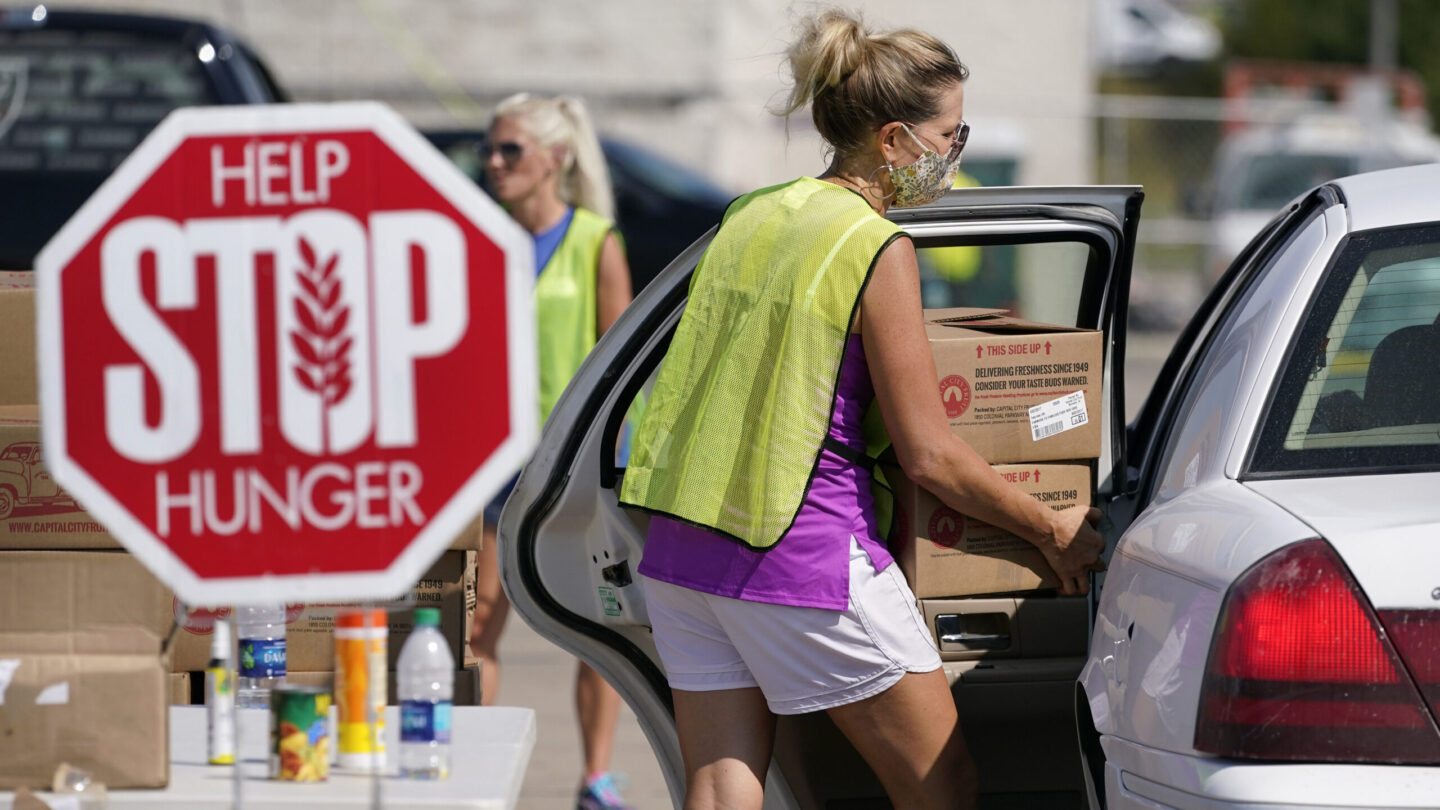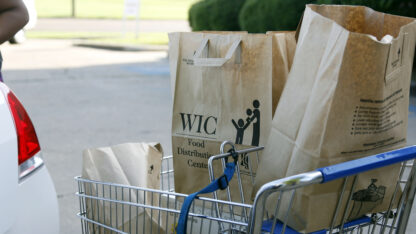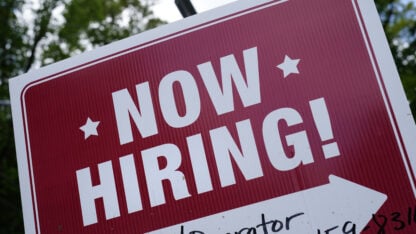The Biden administration wants to end hunger and food insecurity in the U.S. in eight years, an ambitious goal the president set in May – and he’s hosting a big conference in late September to get things started.
It will be the first conference on hunger, nutrition and health since 1969. That Nixon-era conference influenced the food policy agenda for the last 50 years, leading to the creation of big food programs we know today, like food stamps and child nutrition assistance.
“The president sets out to do the same with this year’s conference,” the White House said.
But some are worried the administration won’t be able to meet the high bar of expectations set by the 1969 conference.
“I think it’s a completely different ballgame,” said Lisa Davis, senior vice president of the No Kid Hungry campaign, one of many groups meeting with the White House as it develops the Sept. 28 conference agenda.
That’s because planning for the two conferences has been vastly different. Two months after Congress passed a bill mandating that the White House host it by the end of the fiscal year, Biden announced it would happen in September. That gave the administration just three months total to prepare. By contrast, Nixon prepared for six months. Some with knowledge of conference planning worry that the short turnaround and the fact that the White House has taken months to announce when exactly next month the conference will take place will hurt the administration’s ability to have a policy-changing event.
“I think the follow up is going to be really important,” Davis said. “We’re really hopeful that this doesn’t lead to a very impressive white paper that sits on the shelf and or the outlook file and just gathers dust and it’s forgotten about.”
What will happen at the hunger conference?
The goal of this year’s conference will be to find policy solutions to end hunger, improve nutrition and physical activity, reduce diet-related diseases and close the equity disparities around them.
When Biden announced the conference in video remarks, he called for ideas.
“Too many families don’t know where they are going to get their next meal,” he said. “There are too many empty chairs around the kitchen table because a loved one was taken by heart disease, diabetes or other diet-oriented diseases which are some of the leading causes of death in our country.”
The White House has spent the last few months hosting six listening sessions to prepare, talking to representatives from federal agencies, corporations, health care, conservation and environmental groups, hunger and nutrition groups and school and education groups.
“We’re the wealthiest nation in the history of civilization,” said Vince Hall, chief government relations officer of the nonprofit food bank group Feeding America, whose staff participated in a listening session. “And the idea that millions of our children are going to bed hungry at night is an intolerable crisis that we should resolve to end as quickly as possible.”
The conference is expected to focus on the impact of the coronavirus pandemic — which brought to light diet-related diseases, food access and supply chains.
“The COVID-19 pandemic was a stark reminder of the need for urgent, sustained action. As more Americans experienced hunger, we saw diet-related diseases heighten the risk of severe COVID,” Biden said. “It’s time we committed to real change.”
Also expect a bipartisan showing. Congress threw bipartisan support behind the conference when Reps. Jim McGovern (D-MA) and the late Jackie Walorski (R-IN) and Sens. Cory Booker (D-N.J.) and Mike Braun (R-IN) introduced legislation that was ultimately passed in the spring that allocated $2.5 million for the White House to host it.
McGovern said he has been trying to spearhead another hunger-focused conference since the Obama administration.
“I don’t run into too many people here in Congress who say they’re pro-hunger. We may have some differences of opinion on how to get to the goal. But I would like to think that this is one of those issues that can bring us together,” McGovern told NPR. “Hungry people in this country don’t fall into one category. They’re not just people who are jobless or homeless. They’re working families. They’re people who are working multiple jobs to try to make ends meet but yet do not have the resources to be able to put food on the table on a regular basis for their families.”
What was the impact of the Nixon-era hunger conference?
The three-day 1969 conference on food, nutrition and health produced programs still used today.
Out of the 1,800 recommendations made then, 1,600 were implemented not long after, including the Women, Infants and Children program. WIC, piloted in 1972, serves half the infants born in this country, providing mothers with, among other things, nutrition counseling, parenting advice, breastfeeding support and food assistance.
It also helped pave the way to making the Supplemental Nutritional Assistance Program (SNAP) – known as food stamps – the permanent and bigger program it is today. And it kickstarted more conversation about meal access in schools, which in 1969 was not as mainstream as it is today.
Nutrition and anti-hunger advocates say the ’69 conference set a high bar, and eyes are on how the White House will organize this one — the duration, format and who is included. Groups from food companies like Tyson, to nutrition and food access groups, school leaders and lawmakers are anxious to see how the administration pushes for change through congressional recommendations, executive action and partnerships with nongovernmental organizations. The White House has vowed to announce a “national strategy to end hunger and reduce diet-related diseases” at the conference.
Individual groups and lawmakers – at the federal and local levels – have also held their own meetings to compile recommendations for Biden officials. Recommendation briefs reviewed by NPR include a wide variety of policy proposals like expanding universal free school meals and school cafeteria resources and boosting nutrition assistance programs as well as specific outreach to immigrant, Native American and other marginalized communities.
But advocates are worried it will only be a press conference or will ignore the participation of regular Americans who have experienced hunger.
An administration official confirms to NPR that conference planning sessions have included people who have been food insecure and have used the SNAP program. Individuals from groups like college students, veterans and faith leaders — all members of groups that often lack access to affordable food – have provided input, as did Jose Andres, high-profile chef and founder of the disaster relief nonprofit, World Central Kitchen.
“We very much wanted to shed light on their stories, but also make sure that they’re part of helping us think about what the solutions are as well,” an administration official familiar with the planning told NPR.
The pandemic will play a big role
The 1969 conference came on the heels of the war on poverty, a Lyndon B. Jonson administration effort that included expanding social safety net programs like nutrition assistance.
The 2022 conference comes in the wake of the COVID-19 pandemic, which brought international attention to the connections between food, nutrition and health as those with diet-related diseases were among the first to feel some of the worst symptoms and results of the virus.
Dr. Anthony Fauci, the chief medical adviser to Biden, told NPR that one of the strongest connections to COVID severity is obesity – “which has got to get unpacked and sorted out because there’s got to be a lot of confounding variables in that,” he said. “People who are undernourished and immune-compromised because of that have a greater chance of getting a severe outcome.”
He is not the first Biden official to make this case. Agriculture Secretary Tom Vilsack has long been a proponent of looking at nutrition security and its impact on the pandemic, as has deputy undersecretary Stacy Dean.
“In this moment, I think there’s heightened public awareness of those issues, heightened awareness of how critically important diet health is,” Dean said. “We saw during COVID, the increased incidence and mortality rates for those who are struggling with diet-related disease who contracted COVID.”
The pandemic also had an effect on the rate of food insecurity. Per USDA, that rate was unchanged between 2019 and 2020, in large part because of the massive influx of pandemic aid and assistance to come from the federal government. Still, in 2020, 38 million people lived in food-insecure households.
“We saw in the early days of COVID just how critical food is in our lives. We saw the long lines at the food bank, those streams of cars lined up waiting to collect boxes of food,” said Curt Ellis, CEO of FoodCorps, a nonprofit focused on getting kids healthy food. “We know that the pandemic exposed what has long been true in this country, which is that racism and structural poverty have created a reality where far too many Americans do not have access to healthy, high-quality food on a daily basis.”
But much of that aid — from free school meals to income supplements — is coming to an end, raising alarm among hunger groups who say that even with aid there were large disparities in who was food insecure during the pandemic. For example, the USDA data showed Black and Latino households were disproportionately impacted by food insecurity in 2020, with food insecurity rates triple and double the rate of White households, respectively.
Some groups, like Feeding America, have been talking to the White House about food issues since last year.
“The conversation for the conference has been expanded somewhat to include discussions of health and nutrition and exercise. And we welcome those conversations,” said Hall. “But we have really emphasized to congressional and White House leadership the importance of ensuring that we have a real plan to end hunger.”
But many will weigh the success of the conference on how the White House’s final recommendations are implemented either through swift executive action, partnerships with companies and nonprofits and larger pieces of upcoming legislation like the 2023 farm bill.
“People don’t talk about food, and yet food is the biggest issue across all of these things for health, for equity, for health care spending, for our economy,” said Dariush Mozaffarian, a professor at the Tufts University School of Medicine working closely on the formation of the 2022 conference through the Bipartisan Policy Center. “The bigger picture that will be a measure of success if this starts to enter the national conversation, political conversation, business conversations, people are actually looking at the food system as a problem and an opportunity.”
Copyright 2022 NPR. To see more, visit https://www.npr.org.
9(MDAxODM0MDY4MDEyMTY4NDA3MzI3YjkzMw004))

9(MDAxODM0MDY4MDEyMTY4NDA3MzI3YjkzMw004))








